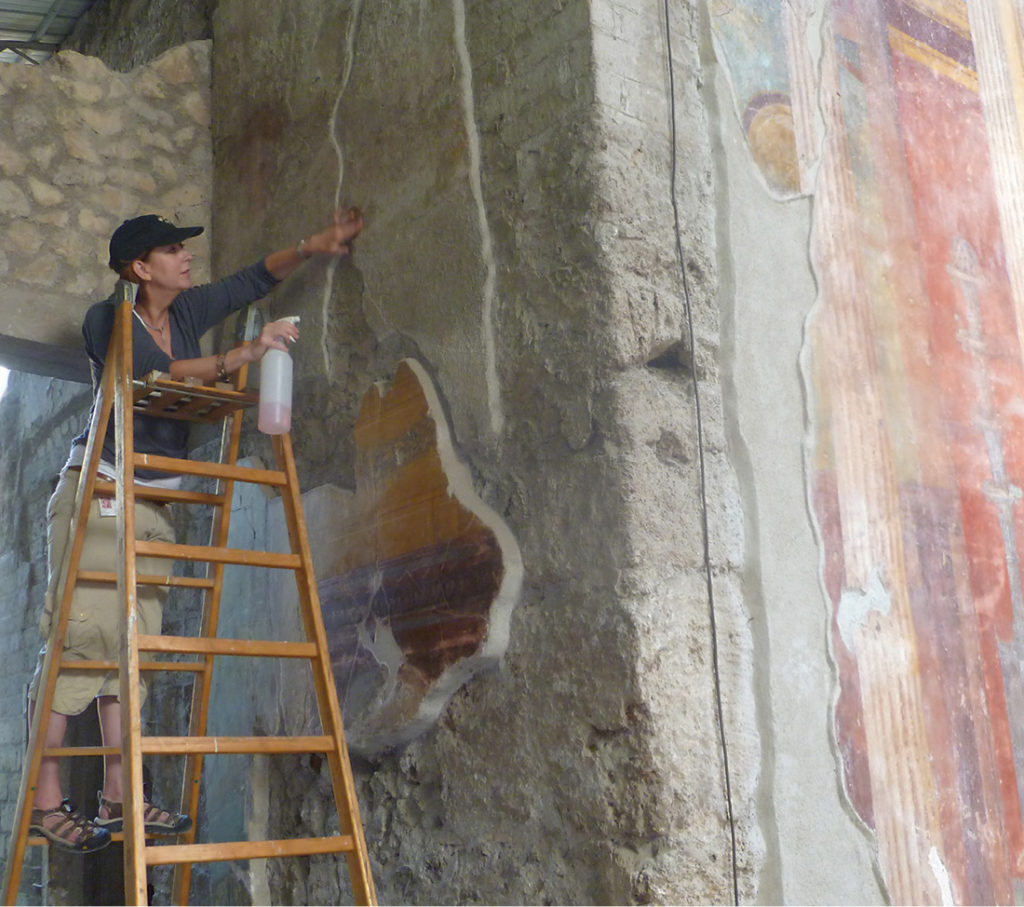
Alumna Regina Gee, BA’86, MA’96, is both art scholar and history detective. As fresco specialist at Oplontis, an archaeological site first discovered in 1590 on the Bay of Naples, she follows ancient residents and their activities within the context of a luxury villa thought to have been owned by a senator of the Roman Republic. Along with the better-known Pompeii, the town of Oplontis was buried under ash when Mount Vesuvius erupted in A.D. 79.
“I recognize people all the time by the marks they make,” Gee says of her work, which necessitates looking closely at individual paintings, studying brushstrokes, and knowing what materials were available at the time for mixing colors. “I can track an artist across rooms because it’s like handwriting. I know how they dip their brush into the paint and make a characteristic mark. These are not famous artists who sign their work. They’re talented non-elites, and possibly slaves.
“It’s my way of finding life as an art historian,” she says, “from the mark-making and the paint mixing.”
Gee, an associate professor of art history at Montana State University, joined the Oplontis Project team in 2009, invited by John R. Clarke, her former professor at the University of Texas at Austin and an expert on Roman antiquities who co-directs the project.
The history of the villa likely extends from around 40 B.C.E., before the Roman Republic ended with Julius Caesar’s murder, through the rule of Nero (54–68 A.D.) and the spread of the Roman Empire. “The villa was more than 120 years old when it died in the eruption, so it has a complicated building history,” Gee says.
Almost as soon as she began work at the site, Gee discussed with Clarke the possibility of organizing an exhibit of artifacts. The culmination of that vision is now at Montana State University’s Museum of the Rockies. Leisure and Luxury in the Age of Nero: The Villas of Oplontis near Pompeii is on the second leg of its U.S. tour, having first stopped at the Kelsey Museum at the University of Michigan. In January 2017 it will travel to the Smith College Museum of Art before returning to Italy.
Numerous interdisciplinary classes have been developed at Montana State around the exhibit’s themes, and rooms from the villa have been recreated to scale in the Museum of the Rockies’ exhibit space.
“We have a lot of interest in cultural geography here,” Gee explains. “It’s a good parallel, being around Yellowstone and the Bay of Naples—living in dangerous, beautiful places with the idea of the consumption of the landscape for luxury. Professors here have developed 14 classes [pertaining to the exhibit], combining disciplines from agriculture and architecture to earth science, politics and literature.”
Gee says Barbara Tsakirgis, Vanderbilt associate professor of classical and Mediterranean studies, and the art history and classics departments prepared her well for her Roman studies.
“Vanderbilt was really important to me, and the time I spent there was pivotal,” she says. “I never thought I would be part of this very complicated scholarly adventure where I get to meet so many people doing so many interesting things. I’m pretty lucky.”
–Bonnie Arant Ertelt